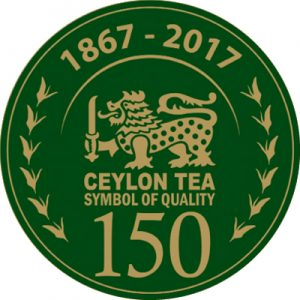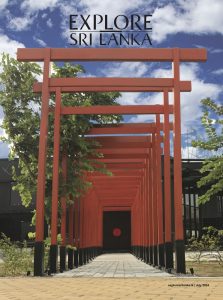
The wild and hilly terrain of lowland Sabaragamuwa province is infused with cool gusts to brew an elegant cuppa with caramel nuances.
Words Keshini de Silva | Photographs Menaka Aravinda and Anuradha Perera
 Tangly greens slope over the undulating land. The soils concealing precious stones, are enriched by the rich bio-diversity of Sinharaja, the Island’s rainforest and the air is refreshed by the cool winds that flow from Uva. Blocks of crop are interspersed with the wild, offering glimpses of order amidst the green clutter. Rubber, cinnamon, clove and pepper are cultivated throughout Sabaragamuwa; yet it is Camellia sinensis or tea that is the true gem.
Tangly greens slope over the undulating land. The soils concealing precious stones, are enriched by the rich bio-diversity of Sinharaja, the Island’s rainforest and the air is refreshed by the cool winds that flow from Uva. Blocks of crop are interspersed with the wild, offering glimpses of order amidst the green clutter. Rubber, cinnamon, clove and pepper are cultivated throughout Sabaragamuwa; yet it is Camellia sinensis or tea that is the true gem.
The tea lands of Sabaragamuwa are different to that of the higher Nuwara Eliya, Uva and Dimbula regions. Tea cultivations on the higher elevations sheath the cold mountains like a carpet of green paving the way towards a towering factory. Yet, here plots of tea appear at random, a small unassuming house at its centre. The plantations are family run and are grown in the acreage surrounding residences, with a few workers employed for plucking. Bagged up they are collected by private factories that span across the region.
Travelling through the remote Kalawana along the Mathugama road the characteristics of this wild wetland that make for a great cup of tea are showcased. Under the thick foliage the climes are moist and cool, yet wherever the sun struck is hot and humid. Typical conditions for an area bordered by the Sinharaja rainforest and Adam’s Peak Wilderness Sanctuary. Wild boar, sambar deer and many endemic birds are frequent visitors.
Smaller factories in the lower regions produce orthodox teas while the larger producers process tea in both CTC (Crush, Tear, Curl) and orthodox methods. Large-leaf orthodox teas are craved for the authentic brew that is strained to the cup, while CTC teas help the busy world experience the true flavours of tea by filling easy-to-use tea bags.
The final product is a full bodied and exceptionally stylish cup with Sabaragamuwa’s distinctive deep orange liquid and hints of caramel
The Ceciliyan Estate, a tea producer in Sabaragamuwa since the 1920’s, produces both. The estate expands into acres of tea, rubber, cinnamon and surprisingly even coconut. Yet, as is common in tea production in the lower elevations, the majority of the leaf required to get the machines of the factory whirring are outsourced. They come from the small plantations in the area, called ‘smallholders’ in industry jargon.
Tea pluckers work throughout the day to snip the two leaves and a bud. An expert eye, nurtured through practice is required to identify the tender buds that should be plucked. The emerging sprout must be left seven days to be ready. The estate too must be curated carefully with high shade and low shade trees shielding the shrubs from the harsh rays of the sun, but allowing just enough sunlight to ensure photosynthesis. Unlike in the higher elevations where tea was first cultivated and bushes have aged up to 60 years; in the lower regions, the seeds are germinated for faster leaf growth and must be replanted every 15 years to maintain character.

The tea factories still preserve their colonial aura. Little changes, like the use of stainless steel have been made to meet sanitation standards. However, the process of withering, rolling and oxidisation still follows British principles and labour-intensive methods required to produce a superior brew. Thus, staff are the core of the tea operation, working in shifts and adjusting their lifestyle accordingly. The CTC production line on the other hand is all about the modern. From a third generation tea manufacturing family, Panini Dias, Managing Director of Ceciliyan remarks that during his father’s time the entire operation was conducted with a few machines for each process. Today’s development of lower region factories into fully-fledged establishments and the rapid growth of smallholder plantations was due to Sri Lankan’s purest brew becoming the choice beverage of Russia and the Middle East.
The final product is a full bodied and exceptionally stylish cup. A deep orange liquid coloured by Sabaragamuwa’s incessant rains similar to Ruhuna’s brew, yet caramel nuances gifted by the areas fertile reddish soil are its hallmark.
Apart from the stems that are sorted out with precision, from dust to leafy grades every aspect of the tea leaf is used to produce teas of varying qualities. From the delicate flowery varieties to dark dusts, there are takers for them all. The high priced specialty tea is sold to the highest bidder at the Colombo Tea Auction. These teas don’t just refresh Middle Easterners or warm up the Russians, many exclusive grades are even bought by the coffee-loving United States to harness complex flavours in chocolate.
The tea industry is intrinsically knitted into life in Sabaragamuwa, instilling a deep appreciation for its rustic landscape. Yet again, as the largest tea producing region in the Island it helps sustain the life blood of the country.





